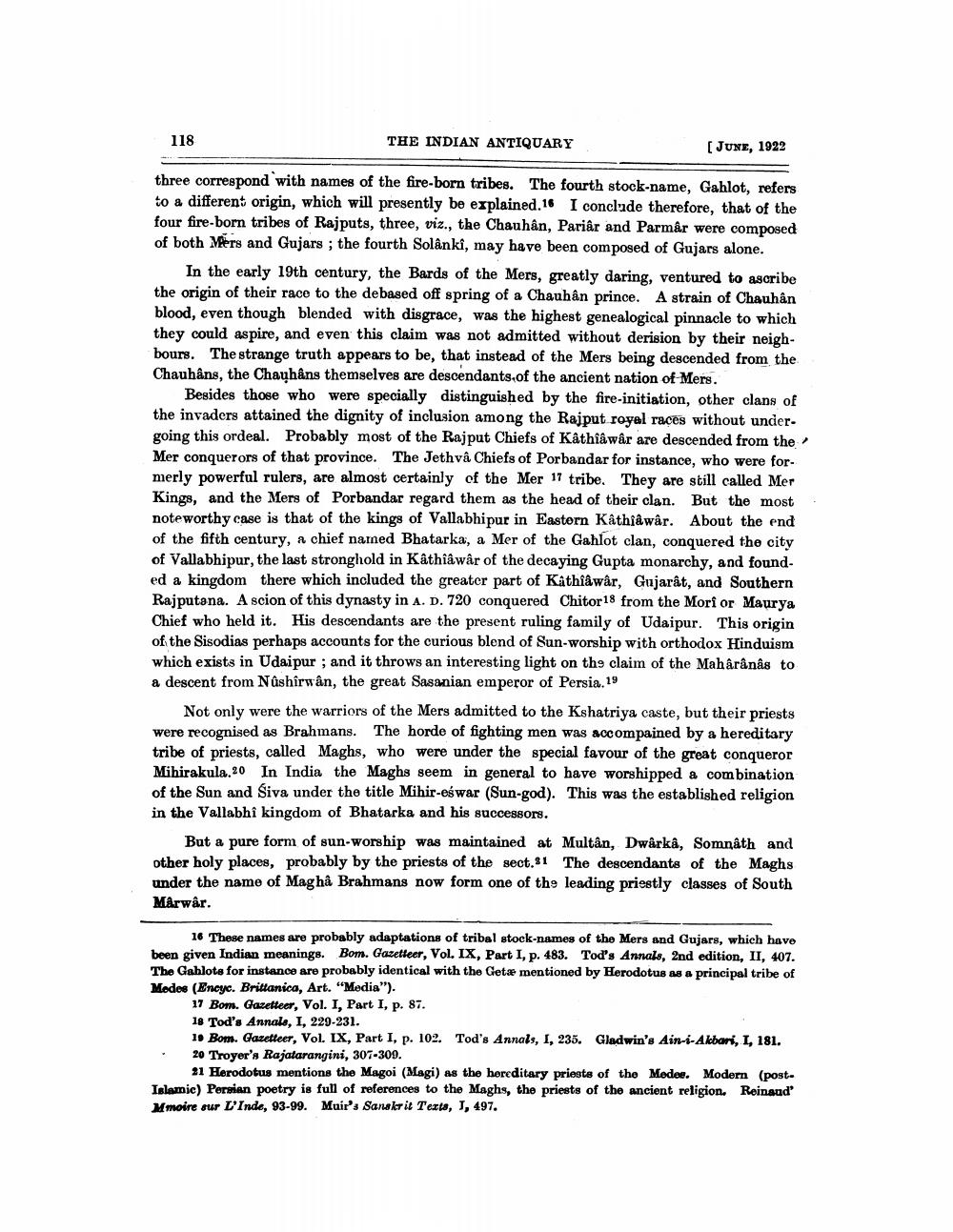________________
118
THE INDIAN ANTIQUARY
(JUNE, 1922
three correspond with names of the fire-born tribes. The fourth stock-name, Gahlot, refers to a different origin, which will presently be explained. 16 I conclude therefore, that of the four fire-born tribes of Rajputs, three, viz., the Chauhan, Pariâr and Parmår were composed of both Mers and Gujars; the fourth Solanki, may have been composed of Gujars alone.
In the early 19th century, the Bards of the Mers, greatly daring, ventured to ascribe the origin of their race to the debased off spring of a Chauhan prince. A strain of Chauhan blood, even though blended with disgrace, was the highest genealogical pinnacle to which they could aspire, and even this claim was not admitted without derision by their neighbours. The strange truth appears to be, that instead of the Mers being descended from the Chauhậns, the Chauhåns themselves are descendants of the ancient nation of Mers.
Besides those who were specially distinguished by the fire initiation, other clans of the invaders attained the dignity of inclusion among the Rajput royal races without undergoing this ordeal. Probably most of the Rajput Chiefs of Kathiâwâr are descended from the Mer conquerors of that province. The Jethvâ Chiefs of Porbandar for instance, who were formerly powerful rulers, are almost certainly of the Mer 17 tribe. They are still called Mer Kings, and the Mers of Porbandar regard them as the head of their clan. But the most noteworthy case is that of the kings of Vallabhipur in Eastern Kâthiâwâr. About the end of the fifth century, a chief named Bhatarka, a Mer of the Gahlot clan, conquered the city of Vallabhipur, the last stronghold in Kâthiâwâr of the decaying Gupta monarchy, and founded a kingdom there which included the greater part of Kathfåwår, Gujarât, and Southern Rajputana. A scion of this dynasty in A. D. 720 conquered Chitor18 from the Mori or Maurya Chief who held it. His descendants are the present ruling family of Udaipur. This origin of the Sisodias perhaps accounts for the curious blend of Sun-worship with orthodox Hinduism which exists in Udaipur ; and it throws an interesting light on the claim of the Mahârânâs to a descent from Nûshîrwân, the great Sasanian emperor of Persia. 19
Not only were the warriors of the Mers admitted to the Kshatriya caste, but their priests were recognised as Brahmans. The horde of fighting men was accompained by a hereditary tribe of priests, called Maghs, who were under the special favour of the great conqueror Mihirakula.20 In India the Maghs seem in general to have worshipped a combination of the Sun and Siva under the title Mihir-eswar (Sun-god). This was the established religion in the Vallabhi kingdom of Bhatarka and his successors.
But a pure form of sun-worship was maintained at Multân, Dwarka, Somnath and other holy places, probably by the priests of the sect.31 The descendants of the Maghs under the name of Maghå Brahmans now form one of the leading priestly classes of South Mârwâr.
16 These names are probably adaptations of tribal stock-names of the Mers and Gujars, which have been given Indian meanings. Bom. Gazetteer, Vol. IX, Part I, p. 483. Tod's Annals, 2nd edition, II, 407. The Gablote for instance are probably identical with the Getæ mentioned by Herodotus as a principal tribe of Medes (Encyc. Brittanica, Art. "Media").
17 Bom. Gazetteer, Vol. I, Part I, p. 87. 18 Tod's Annal, I, 229-231. 19 Bom. Gazetteer, Vol. IX, Part I, p. 102. Tod's Annals, I, 235. Gladwin's Ain-i-Akbari, I, 181. 20 Troyer's Rajatarangini, 307-309.
21 Herodotus mentions the Magoi (Magi) as the hereditary priests of the Medee. Modern (postIslamic) Persian poetry is full of references to the Maghs, the priests of the ancient religion. Reinand' Mmoire sur L'Inde, 93-99. Muir's Sanskrit Texta, 1, 497.




